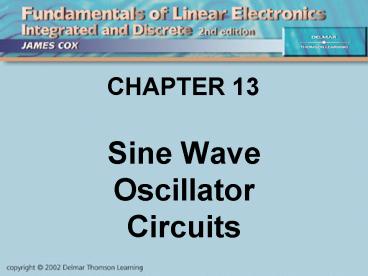Sine Wave Oscillator Circuits - PowerPoint PPT Presentation
1 / 16
Title:
Sine Wave Oscillator Circuits
Description:
CHAPTER 13 Sine Wave Oscillator Circuits Objectives Describe and Analyze: Feedback oscillator theory RC phase-shifting oscillators LC resonant oscillators Crystal ... – PowerPoint PPT presentation
Number of Views:425
Avg rating:3.0/5.0
Title: Sine Wave Oscillator Circuits
1
CHAPTER 13
- Sine Wave Oscillator Circuits
2
Objectives
- Describe and Analyze
- Feedback oscillator theory
- RC phase-shifting oscillators
- LC resonant oscillators
- Crystal oscillators
- Troubleshooting
3
Introduction
- Oscillators use feedback to produce periodic AC
output with DC power as the only input. - In contrast, function generators produce periodic
outputs by joining pieces of wave-forms together.
4
A Bit of Theory
- We know that with negative feedback in an op-amp,
the equation for closed-loop gain in terms of
open-loop gain is - ACL AOL / (1 B ? AOL)
- where B is the feedback ratio set by external
resistors. Now, if there is an additional 180
phase shift in B, we can express it
mathematically as - ACL AOL / (1 B ? AOL)
- In that case, what happens when B ? AOL 1?
- Mathematically, ACL goes to infinity (whatever
that means). Physically, the circuit oscillates
it takes no Vin to get a Vout. The trick is to
get that 180 shift in B, the feedback network.
5
RC Oscillators
- As a group, RC oscillators use an RC network
inserted into the feedback loop of an amplifier
to produce positive feedback at exactly one
frequency. As we just saw, thats the recipe for
oscillation. - One type of RC oscillator is the Wien-Bridge
oscillator. Another is simply called the
Phase-Shift oscillator.
6
Wien-Bridge Oscillator
- Feedback to the () input gt feedback to () input
at fOSC
7
Starting and Running
- A problem with the Wien-Bridge (and with all
feedback oscillators) is that the feedback
necessary to start oscillating is slightly more
than the feedback to maintain a pure sine wave.
If the gain is left too high, the sinewave
amplitude will increase until it hits the rails
and is clipped. - The cure is to include a means for the circuit to
lower its gain a bit once it starts oscillating.
This is a type of negative feedback based on
amplitude.
8
Phase-Shift Oscillator
- The RC phase-shift oscillator is the simplest of
its type. A minimum of three RC LPF sections are
put in the feedback loop of an inverting
amplifier. Each RC stage causes an amount of
phase shift that changes with frequency. At one
specific frequency, the phase shifts of the
network add up to 180. - Since the inverting amplifier has a 180 phase
shift, the total phase shift is 360, which means
it has become positive feedback. The circuit
oscillates.
9
Phase-Shift Oscillator
10
Oscillations in Amplifiers
- The old joke is that, when youre testing them,
oscillators dont oscillate but amplifiers do. If
theres an accidental feedback path from the
output to the input, then its a good bet a
high-gain amplifier will oscillate. Such feedback
paths can be - Through the power rails.
- Through magnetic coupling of signal leads.
- Through capacitive coupling of adjacent
components. - Through unshielded input cables.
- Through putting a microphone too close to a
speaker.
11
LC Oscillators
- Pulsing an LC tank circuit will make it ring.
But the oscillations die off due to I2R losses in
the circuit. If energy could be pumped back into
the tank as fast as it were being dissipated, it
would ring forever. That is the basic idea of an
LC resonant oscillator.
12
Colpitts Oscillator
- A common type of LC oscillator.
13
Hartley Oscillator
- Another type of LC oscillator.
14
Crystal Oscillators
- Piezoelectric crystals behave like extremely
high-Q resonant circuits. - A crystals frequency depends on its physical
dimensions, which can be tightly controlled by
grinding. - LC resonant oscillators can be crystal
stabilized. - A crystal can take the place of an LC tank
circuit.
15
XTAL Oscillator Examples
- Since youre stuck with it anyway, the Pierce
oscillator (b) utilizes stray capacitance for
feedback.
16
Troubleshooting
- Use a frequency counter to check frequency. You
can use an oscilloscope, but your readings will
be off by 5. - Use a X10 probe to minimize loading (they work on
counters too). - At very high frequencies, you dont have to touch
the probe to the circuit, just get it close. - There can be high voltage in a transmitters tank
circuit even if it uses a 12 Volt DC supply.































